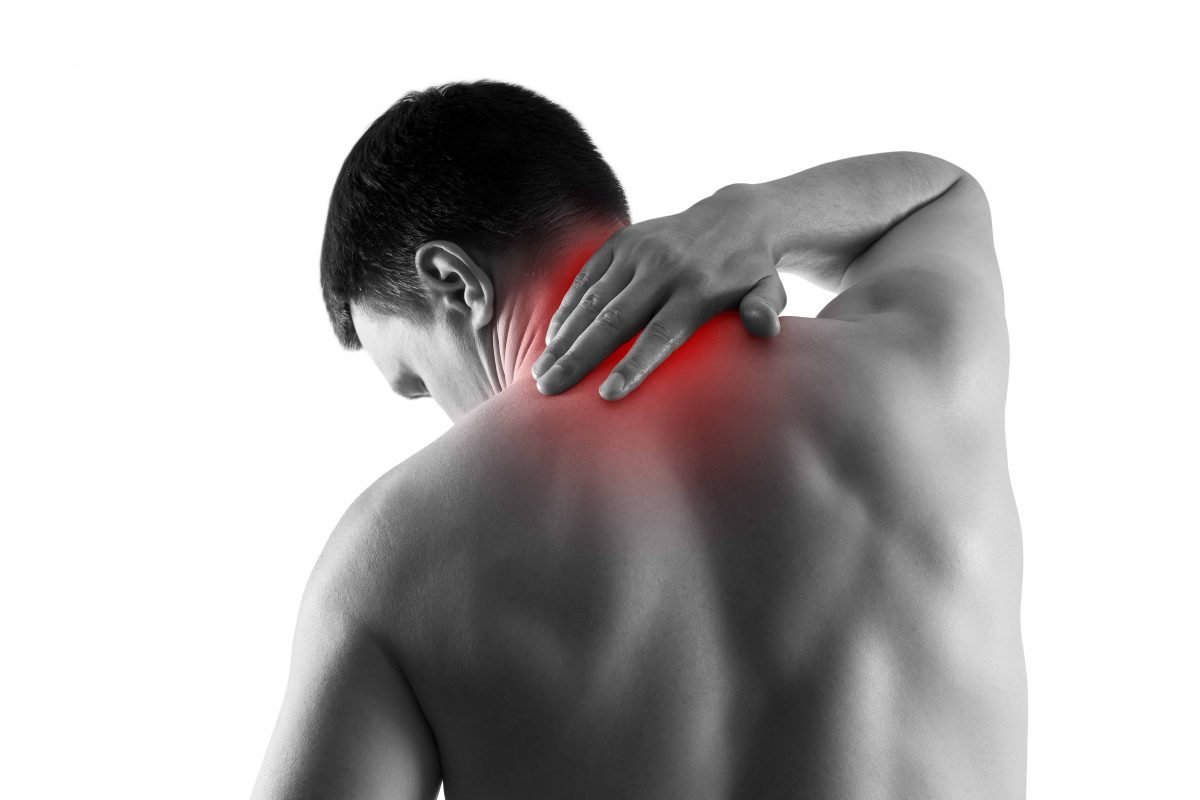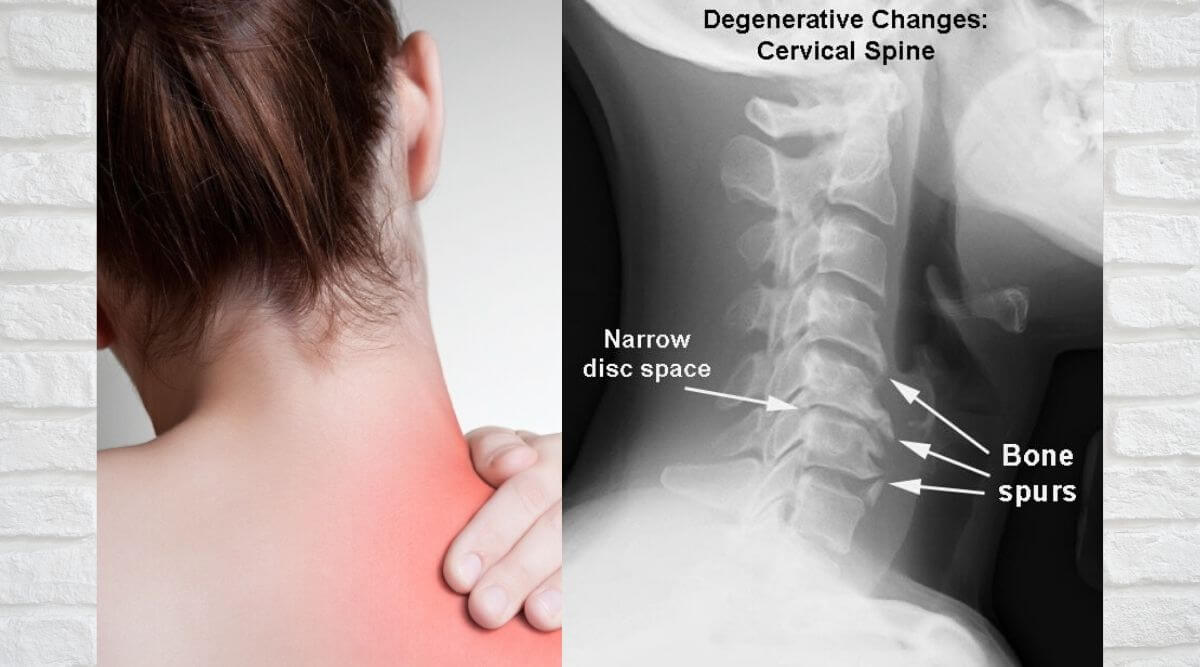The Types Of Neck Arthritis
There are three predominant forms of arthritis in the neck that have different causes, mechanisms, and slightly varying symptoms.
-
Osteoarthritis in the NeckOsteoarthritis in the neck refers to the degeneration of structures in the spinal column typically occurring with age.
With time, the vertebrae progressively lose the padding between them, which causes friction. The latter can lead to the breaking off of tiny bone fragments or enhanced growth of shart bony structures called osteophytes.
Ultimately, in this type, neck arthritis symptoms include neck pain, stiffness, and inflammation that worsens with physical activity.
- Rheumatoid Arthritis in the Neck Unlike osteoarthritis, rheumatoid arthritis is an autoimmune condition, meaning that the body mistakenly attacks the tissues. Usually, the changes predominantly affect the small joints in the hands and feet, but they can also cause arthritis in the neck.
-
Spondyloarthritis Spondyloarthritis is an umbrella term for psoriatic arthritis and ankylosing spondylitis. Both of these neck arthritis causes are autoimmune disorders presenting with chronic joint inflammation.
Psoriatic arthritis comes with psoriasis an autoimmune inflammation of the skin presenting with red, itchy, and scaly patches.
On the other hand, ankylosing spondylitis affects the whole spinal column and the pelvis.
Diagnosing And Treating Neck Arthritis
Diagnosis often starts with a thorough exam, image testing to determine the location of the degeneration, and an electromyogram to check nerve functioning. Physical therapy is frequently recommended to strengthen neck and shoulder muscles. Some patients may be treated with:
- Neck traction to relieve pressure on discs and nerve roots
- Anti-inflammatory medications or muscle relaxants
- Steroid injections to minimize tissue inflammation
- Anti-epileptic drugs to treat nerve damage
- Temporary use of a neck collar or brace
- Application of heat or ice
Neck surgery isnt often recommended for neck arthritis unless the pain is related to a bone spur or a herniated cervical disc thats pinching or compressing a nerve or if the spine is somehow compromised. For most people, cervical spondylosis can be successfully managed with the use of over-the-counter or prescription medication and preventative measures such as strengthening neck muscles.
If you have chronic pain that isnt responding to conservative treatments, consider speaking with a board-certified orthopedic surgeon in Los Angeles. To schedule an in-person consultation, call The Spine Institute today at 828-7757 today.
What Are The Risk Factors For Cervical Spondylosis
Aging is the major factor for developing cervical osteoarthritis . In most people older than age 50, the discs between the vertebrae become less spongy and provide less of a cushion. Bones and ligaments get thicker, encroaching on the space of the spinal canal.
Another factor might be a previous injury to the neck. People in certain occupations or who perform specific activities — such as gymnasts or other athletes — may put more stress on their necks.
Poor posture might also play a role in the development of spinal changes that result in cervical spondylosis.
Also Check: Acute Arthritis Attack
How Does Osteoarthritis Affect The Neck
There are multiple types of arthritis, but osteoarthritis is the most prevalent, affecting a staggering 32.5+ Americans. Age and wear-and-tear from activity are the primary culprits to blame for this condition, which occurs because the pillowy cartilage that protects the tips of your bones simply breaks down.
Osteoarthritis typically causes damage to your spine, knees, hips, and hands, but did you know it can also wreak havoc on your neck? This condition is called cervical osteoarthritis , so named because the arthritic area is specifically in the bones, joints, and discs of your neck.
The extraordinary team at Advanced Spine and Pain has decades of combined experience in treating osteoarthritis, which should give you confidence about entrusting your care to us. Dr. Thomas Raley, Dr. Brian Lee, Dr. Alfred Correa, and Dr. Randy Davis provide an essential but rare combination of excellence in clinical care and true compassion when they treat you.
When Neck Cracking And Popping Needs Medical Attention

If your crepitus neck is accompanied by any of the following factors, you should seek the advice of your doctor as it may be indicative of a more serious issue.
Pain and/or swelling. This may indicate the presence of inflammation and osteoarthritis.
Recent injury. If your crepitus occurs after a recent accident of injury, it may mean that there has been damage to the structure of you neck.
Frequent or constant. If the cracking and grinding noise can be recreated every time you move your head/neck, then it may be telling of an issue with joint function.
Recent surgery. After surgery on the cervical spine, crepitus may occur weeks later. While these new sounds may not mean anything serious, it is important to inform your surgeon so they can assess your symptoms.
You May Like: Pain From Ra
Neck Cracking And Popping Complications
While medical literature assures us that the repeated cracking of any synovial jointsâincluding the neckâwill not increase the risk of arthritis, it may cause other complications. In rare instances, manipulation of the cervical spine may cause vertebral artery dissection that can result in a stroke.
Low Back Pain Caused By Osteoarthritis
The most common symptom of spinal osteoarthritis is pain in the lumbar spine . This pain may also radiate down to the pelvis, buttocks, groin or thighs. It is usually treated through a combination of:
- and that strengthens a person’s core
- , acetaminophen, and/or adjuvant pain medication
When these treatments are not enough to alleviate pain and stiffness, a patient may require procedural pain management, such as or blocking of the medial nerve through radiofrequency neurotomy, where heat generated by radio waves disrupts the nerves ability to transmit pain signals.
Don’t Miss: First Symptoms Of Ra
Rheumatoid Arthritis In The Neck: Causes Symptoms And Treatment
If you experience neck pain as a symptom of rheumatoid arthritis , youre not alone. Although the condition tends to affect the smaller joints in the hands, wrists, and knees, it can affect almost every joint in the body including those in the neck.
RA is a chronic autoimmune disease that occurs when an overactive immune system attacks the bodys healthy tissues. When RA affects the neck, it can cause symptoms such as pain, swelling, and stiffness. Fortunately, there are treatments available that can bring relief to your neck.
Heat And Cold Therapy
Both heat and cold can help alleviate the symptoms of arthritis. Heat therapy helps loosen the muscles around the joint and increase flexibility and circulation, while cold reduces inflammation and dulls pain.
For hot therapy, the Cleveland Clinic recommends showering or soaking in a warm bath for 20 minutes or using a heating pad. Applying a moist dishcloth warmed in the microwave for 20 seconds can work in the same way.
Cold therapy can be applied for 20 minutes at a time using a gel-filled ice pack, frozen peas, or a bag filled with ice.
One myRAteam member recommended trying a moist heating pack: Get a Bed Buddy . Its the best for when pain is out of control.
Another member recommended trying a heated neck wrap around the neck and shoulders for similar relief.
Don’t Miss: Rf Negative Rheumatoid Arthritis
Arthritis Of The Neck
Beacon and TriHealth have teamed up to transform orthopedic care.
Access broader, superior orthopedic services through the combined efforts of two powerhouse providers, driven to provide a model for partnership between independent physicians and health systems in Greater Cincinnati.
Arthritis of the neck is a common condition among older adults. At TriHealth Orthopedic & Sports Institute and Beacon Orthopaedics & Sports Medicine, well work closely with you to help you find relief from arthritis in your neck. Together, well come up with a treatment plan that helps ease your symptoms and gets you back to enjoying the activities you love.
What Are The Best Natural Remedies For Arthritis Of The Neck
You can take natural approaches to slow the progression of arthritis and treat its symptoms. The natural remedies that you should consider are as follows:
H-Arthritis FormulaFor fast relief from arthritis pain, H-Arthritis Formula is your best bet! Its made from 100% natural ingredients so you wont have to worry about adverse side effects. It is applied to the skin and is gentle on it as relieves discomfort and stiffness.
Cold Therapy for Neck ArthritisThis method is used to reduce joint pain, inflammation, and swelling in the neck. Wrap ice in a piece of cloth and press it where the joint pain is. You can also alternatively wrap frozen vegetables in a cloth. Remember to never place ice directly on your skin to prevent cold burns.
ExerciseExercising your neck will help in making your muscles and joints more flexible. It will also help you get rid of the stiffness and discomfort associated with arthritis.
Sleep CorrectlySleeping on a pillow or mattress that doesnt support your neck properly will worsen the pain and stiffness. Different sleeping postures require different texture of mattresses and pillows. For those who sleep on their back, a firm pillow and mattress are recommended. For side sleepers, they should get a medium pillow and mattress. For stomach sleepers, a soft pillow and mattress will do. For even better support for your neck, go for a cylindrical pillow that the curve of your neck can rest on.
You May Like: Autoimmune Leg Pain
Vs Symptoms Of Osteoarthritis In The Neck
Osteoarthritis in the neck is a type of arthritis that happens due to wear and tear of the joints, vertebrae, and discs in the neck.
Most people have no symptoms of osteoarthritis in the neck. If people do have symptoms, they can include:
- mild to severe pain and stiffness in the neck
- pain that is worse after activity
- pain that gets worse when looking up or down, or holding the neck in a set position for a long time
- pain may improve when lying down or resting
- numbness, tingling, or weakness in hands, arms, or legs
- muscle spasms in the neck or shoulders
What Are The Signs Of Neck Arthritis

Pain is the most obvious symptom of a disk problem in the neck, yet the degree of damage has little to do with how much it hurts.
You can have 100 people with the same amount of degenerative changes in their cervical spine, and only a small percentage have neck pain, says Dr. Mroz. Among those who do experience neck pain, the discomfort is usually short-lived, improving on its own within six to 12 weeks.
Sometimes, cervical arthritis narrows the space where nerve roots exit the spine, pinching the nerve. You can feel this as a radiating pain down your arm, or as numbness and weakness in your arm and hand. If a collapsed disk or a bone spur pushes into the spinal cord and causes compression, it can produce more serious symptoms
Read Also: How To Relieve Arthritis Pain In Lower Back
Osteoarthritis In The Neck
Osteoarthritis in the neck is the degeneration of joints, vertebrae, and discs in the cervical portion of the spine. With less padding between them, vertebrae may rub against each other. That can cause tiny bone fragments to break off and float in the synovial fluid .
Sometimes this process stimulates the growth of bony projections along the edges called bone spurs, or osteophytes. Since the padding is now thinner, the vertebrae become closer to each other. That leaves less room for the spine nerves that stick out from the spinal cord.
Symptoms of neck osteoarthritis range from none to pain, stiffness, and inflammation. Osteoarthritis in the neck pain tends to worsen after activity. Complications such as loss of coordination can happen if the spinal cord becomes pinched.
What Causes Arthritis In The Neck
Arthritis in the Neck , sometimes called cervical facet joint syndrome, is a degenerative condition that causes pain and stiffness in the neck , region of the spine. The cervical spine includes the top seven vertebrae of the spine. There are two facet joints on either side of the back of each vertebra in the neck. These joints provide stability, while also enabling neck movements such as turning or nodding the head.
Cartilage lines each facet joint in the neck, and this cartilage is surrounded by a capsule filled with synovial fluid. This synovial fluid helps lubricate the facet joint, enabling smooth movements of the joint complex. In arthritis in the neck , this cartilage begins to degenerate, or break down. The cartilage begins to thin and can sometimes, in acute cases, even disappear completely, causing bone-on-bone friction of the facet joints in the neck, and this is what leads to the development of osteophytes, or bone spurs., ,
If these osteophytes impinge on any cervical nerve roots, pain, weakness, or tingling may radiate along the path of the nerve into the arm and hand. Cervical osteoarthritis can cause pain in the neck and upper back as well as the shoulders and between the shoulder blades. In some cases it can also result in headaches, a form of radiated or referred pain, especially in the back of the head.
Also Check: Arthritis Articles
Treatment Options For Cervical Osteoarthritis
Cervical osteoarthritis can usually be successfully managed without surgery. Common treatments include:
- Rest or activity modification. Going easy on the neck during a painful flare-up may ease pain. Also, you may need to modify some activities, such as using a different swim stroke if you enjoy swimming.
- Physical therapy. A physiatrist, physical therapist, or other medical professional can customize a neck exercise program for you. A stronger and more flexible neck has improved function, which may reduce pain.
- Over-the-counter medications. Non-steroidal anti-inflammatory drugs may help relieve inflammation from osteoarthritis. A few examples include ibuprofen and naproxen . Remember to carefully read the instructions before using any medication to reduce the risk for serious complications.
Cervical Ra Diagnosis Is Complicated
Doctors may test to see if you have rheumatoid arthritis of the cervical spine by first performing a physical exam. Flexion, extension, and right and left lateral neck movements may be limited and painful if the atlantoaxial joint is involved.
When initially diagnosing rheumatoid arthritis, doctors may take blood as well, looking for C-reactive protein, rheumatoid factor, anti-citrullinated protein antibodies, antinuclear antibodies, and an elevated erythrocyte sedimentation rate. However, all this blood work could come back negative and a rheumatoid arthritis diagnosis might still be made. Key questions and a careful exam remain crucial. Its a field where we still rely on a good history and physical to help make the diagnosis, Dr. Chi said. Up to 20% of patients can have RA and be seronegative.
Also Check: Arthritis Skin Rash
How Is Cervical Spondylosis Diagnosed
The doctor will generally begin by asking you about symptoms and taking a medical history. This will be followed by a physical exam of the body, with a focus on the neck, back, and shoulders. The doctor is also likely to test reflexes and the strength of hands and arms, check for loss of sensation, and watch you walk.
Other tests that might be done include imaging exams such as X-rays, computed tomography , and magnetic resonance imaging . MRI scans use large magnets, radio waves, and a computer to produce the best images of the body. You might also be referred to a neurologist.
More Things You Should Know About Neck Arthritis
Arthritis of the neck orcervical osteoarthritis involves degenerative changes in the joints of the neck. These are often due to wear-and-tear of normal aging. As you grow older, the discs between the bones of the neck gradually wear down, lose lubrication, and become stiff. Cervical osteoarthritis usually begins in middle age and progresses as you grow older.
Along with disc degeneration, abnormal growth of bones called spurs or osteophytes may occur in the neck. These bony growths can cause narrowing of the spinal canal, which contains the spinal cord or in the outlets where your spinal nerves pass.
Symptoms of cervical osteoarthritis include:
- Neck pain and stiffness
- Headache originating in the neck
- Shoulder or arm pain
- Limitation of neck movement
- Grinding sensation or crackling sound in neck
These symptoms are often severe in the morning and later in the day. However, they usually improve with rest. Treatment is usually conservative and includes the use of pain relievers or nonsteroidal anti-inflammatory drugs and other non-narcotic medications to reduce pain and inflammation.
Chiropractic manipulation, physical therapy, and use of a cervical collar can also help improve symptoms. Severe pain and inflammation may also be relieved by injecting corticosteroids and local anesthetic into the neck joints or the epidural area surrounding the spine. Surgery is rarely required.
Don’t Miss: Lower Back Arthritis Cure
Using Heat And Ice Packs
Applying a heat pack to your neck can help to ease pain. You can use a microwavable wheat bag, a hot-water bottle or a reusable heat pad which you can buy from chemists and sports shops. An ice pack, or even a bag of frozen peas, can also be helpful.
Make sure you wrap heat or ice packs in a towel and dont put them directly onto your neck to avoid burning or irritating your skin. You might want to consider applying a heat pack to your neck before and after exercise to help soothe the muscles.
Pain Management And Treatment Options For Ra In The Neck

If you experience RA symptoms in your neck, it is important that you seek medical advice by talking to a rheumatologist. RA in the neck joints can cause several complications, so you should aim for a prompt diagnosis and swift treatment. Your doctor will be able to determine what treatment or combination of treatments could help alleviate your pain and reduce swelling.
Your rheumatologist may prescribe or recommend the following to treat rheumatoid arthritis in the neck.
You May Like: Is Peanut Butter Bad For Arthritis